
Introduction
Backhoes and excavators are two of the most commonly used machines in construction and landscaping. While both are designed for digging and earthmoving, the Backhoe vs. Excavator debate often arises due to differences in structure, functionality, and best-use scenarios. This guide compares Backhoes and Excavators to help you choose the right equipment for your project.
Overview of Backhoes

A backhoe, also known as a tractor loader backhoe (TLB), is a versatile excavating machine designed for various construction and agricultural tasks. It combines a loader at the front and a backhoe at the rear, allowing for efficient loading and digging operations.
Key Components and Functions
- Chassis and Wheels: The backhoe is mounted on a wheeled chassis, providing mobility and stability on various terrains.
- Front Loader: A bucket or scoop is attached to the front end, enabling the loading and moving of materials such as soil, gravel, or debris.
- Rear Backhoe: The backhoe component consists of a boom, dipper stick (arm), and bucket. It is designed for excavating, trenching, and digging operations. The boom can be raised or lowered, and the dipper stick and bucket can be extended or retracted to reach desired depths and angles.
- Hydraulic System: Both the front loader and rear backhoe are powered by a hydraulic system, which provides the necessary force and control for their movements. The hydraulic system includes pumps, reservoirs, and control valves.
- Operator’s Cabin: The backhoe features a cabin or compartment for the operator, equipped with controls and displays for operating the machine’s various functions.
Overview of Excavators

An excavator is a versatile and powerful construction machine designed for heavy-duty tasks such as excavation, demolition, and material handling. It features a rotating upper structure, hydraulic attachments, and a tracked or wheeled undercarriage, making it ideal for a wide range of construction, landscaping, and mining applications.
Key Components and Functions
- Undercarriage: The undercarriage, equipped with tracks or wheels, provides mobility and stability on various terrains. Tracks are ideal for rough and uneven surfaces, while wheels offer better maneuverability on smooth grounds.
- Upper Rotating Structure: This structure houses the operator’s cabin, engine, and counterweight. It can rotate 360 degrees, allowing efficient digging and material handling without repositioning the entire machine.
- Work Attachment: The primary tool for excavation includes the boom, stick, and bucket. These components work together to dig, lift, and move materials. The attachment can be replaced with other tools like grapples or hammers for specific tasks.
- Hydraulic System: The hydraulic system powers the excavator’s movements, including the rotation of the upper structure and the operation of the work attachments. It consists of pumps, cylinders, valves, and hydraulic fluid to ensure smooth and precise operation.
- Engine: The engine provides the power required for both the hydraulic system and the excavator’s propulsion. Modern excavators often feature fuel-efficient and eco-friendly engines.
- Operator’s Cabin: The cabin is equipped with ergonomic controls, displays, and visibility features, ensuring the operator can safely and efficiently control the machine during operation. It may also include air conditioning and soundproofing for comfort.
Backhoe vs. Excavator: Key Differences
Design and Construction
Both backhoes and excavators have a boom, stick, and bucket as the excavating assemblage. However, there are fundamental differences in their design:
- Backhoes are mounted on a tractor or machine body moveable on wheels or tracks. The entire excavating assemblage swings in a horizontal plane relative to the machine body.
- Excavators have the excavating assemblage mounted on an upper turning body that rotates relative to an undercarriage. The position is altered by rotating the entire upper body, not swinging in a horizontal plane.
Operation and Functionality
The differences in design lead to differences in operation and functionality.
- For backhoes, the operator faces the rear during excavation, with the front of the tractor facing the proposed trench. To reposition, the operator must swivel the seat to face the front.
- Excavators allow the operator to remain seated in one position while rotating the upper body to reposition the excavating assemblage.
- Backhoes are often paired with a front loader bucket, making them more versatile for excavating and loading.
- Excavators have greater digging capability and maneuverability for tasks like bottom digging, top digging, and loading at different levels.
Applications
The differences make backhoes and excavators suitable for different applications:
- Backhoes are commonly used for trenching operations and other excavation tasks where mobility and versatility are required.
- Excavators are better suited for heavy-duty construction operations, such as digging, ground leveling, and carrying/dumping loads, especially in confined spaces or challenging terrain.
In summary, while backhoes and excavators share some similarities in their excavating assemblage, they differ fundamentally in design, operation, functionality, and suitable applications, with excavators being more specialized for heavy-duty construction tasks and backhoes offering greater mobility and versatility for excavation and loading.
Pros and Cons
Backhoe Pros:
- Versatility: Backhoes are often combined with a front loader, providing dual functionality for digging and material handling on a single machine.
- Compact size: Their smaller size makes backhoes more maneuverable in confined spaces and suitable for urban construction sites.
- Cost-effective: Backhoes generally have lower initial and operating costs compared to larger excavators.
Backhoe Cons:
- Limited digging depth and reach: The backhoe design limits the maximum digging depth and horizontal reach compared to excavators.
- Operator visibility: During excavation, the operator faces rearward, reducing visibility to the front working area.
- Stability concerns: The rear-mounted backhoe can cause stability issues, especially when working at maximum reach or on uneven terrain.
Excavators Pros:
- Greater digging depth and reach: The excavator design allows for deeper excavations and longer reach compared to backhoes.
- 360-degree rotation: The ability to rotate the upper body provides improved flexibility and precision in positioning the bucket.
- Improved operator visibility: The operator faces the work area, providing better visibility and control during digging operations.
Excavators Cons:
- Larger footprint: Excavators require more space on job sites due to their size and swing radius, which can be challenging in confined areas.
- Limited mobility: Excavators are less mobile compared to backhoe loaders, making them less suitable for frequent relocation on job sites.
- Higher costs: Excavators generally have higher initial purchase costs and operating expenses than backhoes.
Equipment Costs
Backhoes are generally less expensive to purchase than excavators. A typical backhoe loader costs around $80,000 to $150,000, while excavators range from $100,000 to over $500,000 for larger models. However, excavators tend to have a longer lifespan and higher resale value.
Operating Costs
Backhoes are more fuel-efficient for lighter applications, but excavators are better suited for heavy-duty work. Excavators require less operator skill and experience, reducing labor costs. Backhoes have higher maintenance costs due to their articulated design and more moving parts.
FAQ
Can a backhoe perform the same tasks as an excavator?
- Backhoes are versatile but less efficient than excavators for large-scale digging.
Can backhoes and excavators use the same attachments?
- Some attachments are interchangeable, but many are machine-specific.
Which machine is more fuel-efficient: a backhoe or an excavator?
- Backhoes are generally more fuel-efficient for lighter tasks, while excavators consume more fuel for heavy-duty work.
Can I drive a backhoe or an excavator on public roads?
- Backhoes can be driven on roads, but excavators typically require trailers for transport.
Which machine is better for small construction projects?
- For small construction projects, a backhoe is often more suitable due to its versatility and ability to perform multiple tasks. Its smaller size also makes it easier to maneuver in confined spaces.
To get detailed scientific explanations of Backhoe and Excavators, try Patsnap Eureka.

